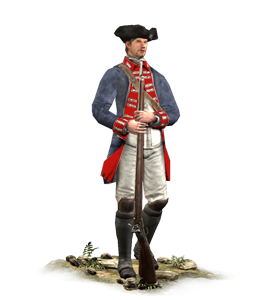Difference between revisions of "Hessian Line Infantry (ETW Unit)"
m |
m |
||
| Line 21: | Line 21: | ||
Line infantry regiments remained unchanged throughout the period, and their organisational pattern still forms the basis of modern military units. | Line infantry regiments remained unchanged throughout the period, and their organisational pattern still forms the basis of modern military units. | ||
| − | == | + | ==Details== |
Hessian line infantry are slightly inferior to regular British line infantry in every way. However, early in the game they can be recruited in almost any city (including civilian buildings) and are cheaper to field and maintain, so they do have the benefit of flexibility. They are particularly useful when attempting to defend Rupert's Land from the aggressive Hurons in the first few turns. They are also available to the Thirteen Colonies, but not the United States. There is a limit of five units at any one time. | Hessian line infantry are slightly inferior to regular British line infantry in every way. However, early in the game they can be recruited in almost any city (including civilian buildings) and are cheaper to field and maintain, so they do have the benefit of flexibility. They are particularly useful when attempting to defend Rupert's Land from the aggressive Hurons in the first few turns. They are also available to the Thirteen Colonies, but not the United States. There is a limit of five units at any one time. | ||
| − | |||
==Factions== | ==Factions== | ||
| + | {{List Column|1| | ||
*[[Image:Britain_flag.jpg|25px]] [[Great Britain (ETW Faction)|Great Britain]] | *[[Image:Britain_flag.jpg|25px]] [[Great Britain (ETW Faction)|Great Britain]] | ||
| + | *[[Image:13_colonies_flag.jpg|25px]] [[Thirteen Colonies (ETW Faction)|Thirteen Colonies]] | ||
| + | }} | ||
[[Category:Empire Total War Units]] | [[Category:Empire Total War Units]] | ||
[[Category:ETW Infantry]] | [[Category:ETW Infantry]] | ||
Revision as of 12:43, 7 January 2013
Overview
“Marching regiments” or “line battalions” make up the majority of units in European-style armies. They are so called because they form the line of battle, not because they always deploy in lines. Indeed, over time the capabilities of line infantry should improve as new tactics, drill and weaponry are developed.
These soldiers carry muzzle-loading, smoothbore muskets firing lead balls as wide as a man’s thumb. These are inaccurate weapons, effective only over 200 paces or so and when fired in massed volleys. The ability to fire and reload with machine-like regularity with shot and bullet flying and comrades falling all around is what wins battles.
Historically, in many armies colonels received a fee to raise regiments, which remained their personal property and commands. They jealously guarded their rights to appoint friends, relatives and hangers-on as regimental officers. This contractor system, however, allowed unscrupulous officers to make handsome profits by pocketing the pay of non-existent soldiers. The better colonels did take a pride in their regiments, spending their own fortunes on good uniforms and weapons. The capabilities of a “standard” line infantry unit therefore varied between nations and over time. It wasn’t until the 1760s that anything approaching uniformity of drill, equipment and regulations became the norm.
Line infantry regiments remained unchanged throughout the period, and their organisational pattern still forms the basis of modern military units.
Details
Hessian line infantry are slightly inferior to regular British line infantry in every way. However, early in the game they can be recruited in almost any city (including civilian buildings) and are cheaper to field and maintain, so they do have the benefit of flexibility. They are particularly useful when attempting to defend Rupert's Land from the aggressive Hurons in the first few turns. They are also available to the Thirteen Colonies, but not the United States. There is a limit of five units at any one time.
